Metal is the most widely used base material in jewelry. Currently, apart from traditional precious metals like gold and silver, there are many trending metals and alloys widely used in fashion jewelry design.
In today’s post, I’ll introduce different types of jewelry metals and alloys. Before buying metal jewelry for your business or personal uses, you must read it.
1. Three Types of Precious Metals for Jewelry
Precious metals represent rare and valuable metals, which often feature high stability, resistance to corrosion, and great ductility. These metals for jewelry mainly used in jewelry include gold, silver, and platinum.
Gold
Almost 50% of the world’s gold is used in jewelry products. Pure gold is ductile, soft and shiny. But due to softness, jewelry made of pure gold is prone to scratching and transform.
To change its hardness, ductility, and save the cost as well, people often use gold alloy in the market, namely k gold. Pure gold is called 24k gold. There are other types of k gold for jewelry:
- 18k gold
- 14k gold
- 10k gold
In general, high-karat gold jewelry is less strong and durable as compared to low-karat.
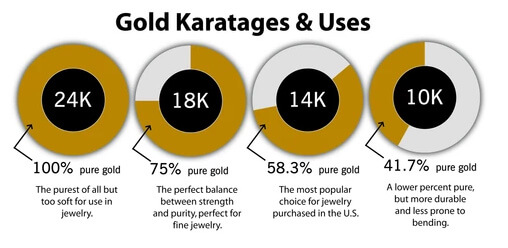
18k gold
18k gold refers to 75% pure gold. It also contains 5% silver and 20% copper. It is a common gold in the market. 18K gold has high hardness and perfect gold luster after polishing, so it is widely used in jewelry.
14k gold
14k gold has 58% pure gold. It also contains other elements like copper, zinc, nickel, etc. It is cheaper but still has a similar property with gold. It is the most popular choice in the market, especially in the US.
10k gold
10k is 41.7% pure gold. It has a low percentage of gold so it features light yellow. It is more affordable and durable.
Platinum
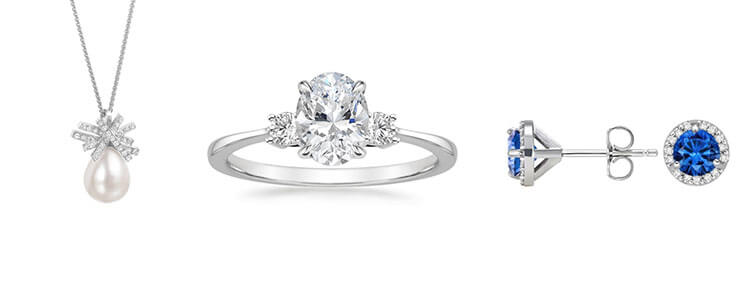
Platinum is a rare and expensive metal, which has a very strong corrosion resistance but is. People usually use platinum alloy to make jewelry, including pt950, pt900, and pt800, the purity of Pt is from high to low one by one, so is the price.
Platinum alloy is composed of platinum and palladium or iridium. Platinum alloy is hard, and silver. It has good stability so the jewelry will not tarnish or change color easily.
Also, it has excellent luster and malleability so that platinum jewelry is often decorated with diamonds or pearls. And it is good to process.
Other metals in Platinum alloy can help to harden the jewelry. Below are the metals composed of the platinum alloys:
- Rhodium (Rh)
- Ruthenium (Ru)
- Palladium (Pd)
- Iridium (Ir)
- Platinum (Pt)
- Palladium (Pd)
Silver
Silver is less expensive as compared to gold and platinum. It is considered the 3rd noble metal after gold and platinum.
Silver is a popular metal used in jewelry. However, jewelry suppliers don’t use 100% pure silver to make jewelry because silver is too soft and softer than gold or platinum.
Thus, they often add 7.5% copper to sterling silver to improve the luster, brightness, and hardness of the silver. And we call this 92.5% pure silver 925 silver.
925 silver jewelry is a good choice among fashion jewelry because it looks high-grade. No matter earrings, bracelets, necklaces, or rings, 925 sterling silver jewelry is the most common and most popular.

Besides 925 sterling silver, there are also other types of silver alloyed with other metals:
- Mexican Silver (95% silver and 5% copper)
- Coin Silver (90% silver and 10% copper)
- Britannia Silver (almost 95% silver)
2. Six Types of Base Metals for Jewelry
In general, base metals refer to metals that may tend to oxidize and corrode versus precious metals.
Among these base metals, stainless steel and copper are the most common in fashion jewelry. In addition, titanium, iron, brass, and other alloys are also common in the market.
Stainless steel
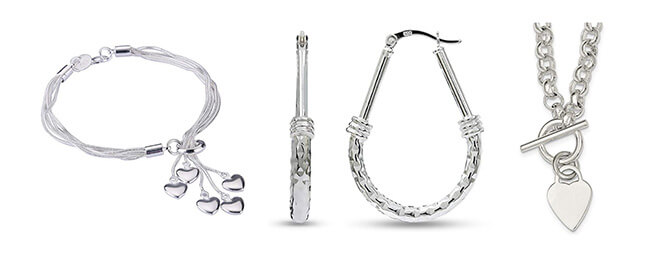
Stainless Steel is gaining popularity for jewelry due to its affordable prices and durability. Stainless steel jewelry plated with 14k gold or 18k gold is durable, affordable to use on different occasions.
The durability of stainless steel jewelry has the upper hand over other metals. It has strong resistance to chemicals, the environment, and water.
There are mainly 4 grades of stainless steel used in jewelry:
- 204 stainless steel
- 304 stainless steel
- 316 stainless steel
- 316L stainless steel
Among these, 304 and 316L are the most commonly used.
316L stainless steel has 20% chromium and 11% nickel whereas 304 stainless steel has 19% chromium and 10% nickel. The presence of nickel can cause severe skin allergy to nickel-prone skins while the higher the chromium level the better for skin safety.
Thus, in contrast, 316L stainless steel is better than 304 while 304 stainless steel is cheaper and more common in the market.
Besides, it’s hard to tell the differences between the 316L and 304 stainless steel from their appearance and features.
Hence, to save cost, many manufacturers may use 304 stainless steel as 316L stainless steel to cheat on the buyers. When you buy stainless steel jewelry, you’d better make a test for the products.
If you’re still wondering whether stainless steel jewelry is good, you can check my previous guide about the pros and cons of stainless steel.
Copper
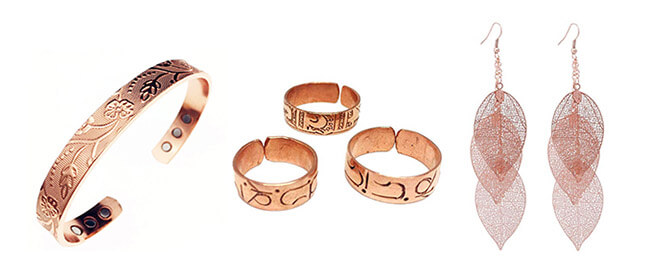
Copper is highly durable and copper jewelry can last for a long time in spite of daily wear. It is often set as the base for jewelry and matched with leather or gemstones.
Initially, copper jewelry presents an orange-red hue. But as time passes, it will turn green and gradually develop patina due to the wear.
As a metal, it is antimicrobial and antifungal, and won’t hurt our skin. Moreover, copper jewelry is versatile and can easily designed to different shapes.
Copper alloys like brass and bronze are also popular in the market, especially brass jewelry. Next, I’ll introduce brass for you.
Brass
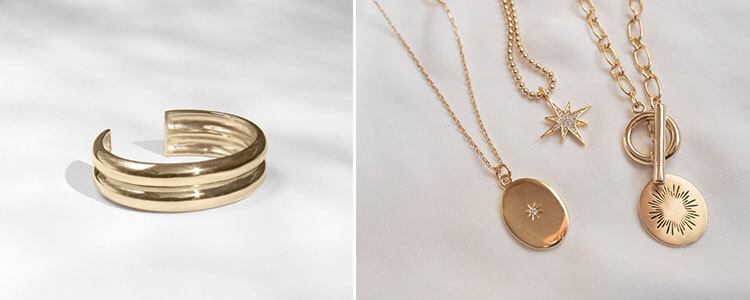
Brass is a kind of copper alloy mixed with zinc. It’s harder and stronger than copper metal because of the zinc in it. The more Zinc in brass, the more malleable and ductile brass will be.
Comparing to copper, brass is more durable. If you want to know more distincts, you can check another blog to know more differences between copper and brass.
Besides, copper and gold both have a yellow appearance but copper is quite cheaper than gold. Some unscrupulous merchants may even counterfeit brass jewelry as gold jewelry. So you should also check the metals before buying.
However, a lot of people are allergic to brass jewelry so earrings are usually made from other metals like silver rather than brass.
Titanium
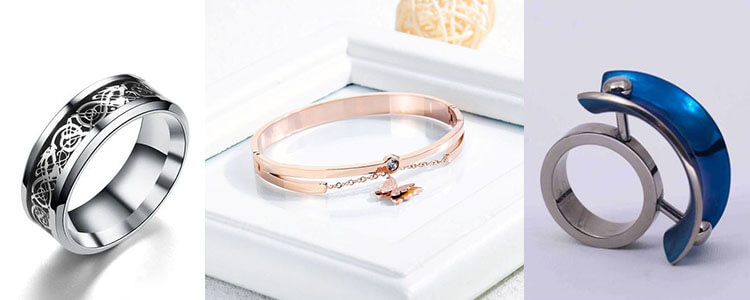
Titanium has a density of only 4.51g/cm³. In simple terms, when titanium is used to make jewelry, it weighs only about a quarter as much as traditional precious metals. Using titanium as a material can greatly reduce the weight of the jewelry, making wearing high-end jewelry more pleasant.
Moreover, due to the high melting point, hardness, Titanium metal is hard to process. Processed Titanium will form a transparent layer, which will refract light so that we can see the colorful surface in Titanium jewelry.
Besides, Titanium metal is colorful, stable, and hypoallergenic so it is also popular in fashion jewelry. Also, we can find some high-end jewelry made from Titanium.
Iron
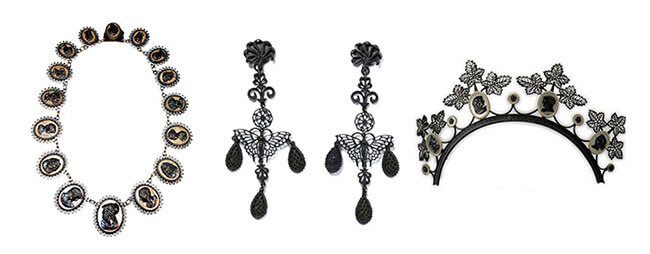
We all know that iron is very easy to oxidize and rust so it’s relatively rare in jewelry. But sometimes there will be some sellers who use the iron as small components to lower the cost.
The most well-known iron jewelry is Berlin Iron Jewelry, which was made during the early 19th century in Germany. And now, some people try to create a retro look like Berlin Iron Jewelry, which is popular nowadays.
Aluminum
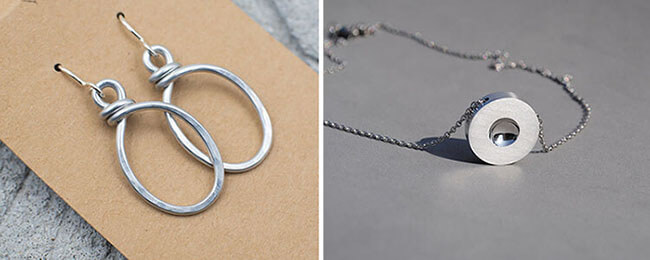
Aluminum is a soft metal and it is excellent for embossing and metal stamping, as well as layering and riveting.
Aluminum does not rust, nor does it take a patina with the standard chemicals normally used to darken jewelry. It oxidizes the moment it comes into contact with oxygen or water. But the element produced will protect it from further corrosion.
But it’s better not to touch aluminum jewelry directly with your body. Since aluminum may cause healthy hazards. In general, aluminum is used to make the pendant of earrings or nacklace.
3. Four Types of Alloys for Jewelry
In general, base metals refer to metals that may tend to oxidize and corrode. Among these base metals, stainless steel and copper are the most common in fashion jewelry. In addition, titanium, iron, brass, and other alloys are also common in the market.
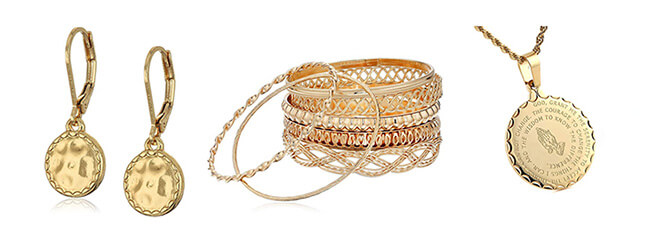
Gold-plated Alloy
As we mentioned above, jewelry made of base metals like copper, stainless steel, and more usually improve their features by plating gold-coating.
The surface gold coating can replace the original material with a golden luster, thus improving the value of the jewelry. The gold content of gold plating are usually 14k and 18k.
The coating thickness of the alloy jewelry determines the service life of the jewelry, so thick coating means long-time use in some way. But correspondingly, the thicker the coating is, the higher the price will be.
The most commonly used thickness is 0.025~0.03mil. The “mil ” here is the thickness unit of the plating of the jewelry, 1mil=1/1000inch=0.00254cm=0.0254mm.
In China, most of the factories with good electroplating technology are located in Guangdong province.
Copper-nickel Alloy
This is a kind of copper alloy. The proportion of this alloy is 65% copper, 18% nickel, and 17% zinc. Due to shiny silver nickel, this alloy features a similar luster with the metal silver.
Copper-nickel is resistant to oxidation, corrosion and it is easy to process. So it is also widely used in fashion jewelry.
Lead-tin Alloy / Pewter
Lead-tin alloy is soft and malleable. Old lead-tin alloys frequently contain lead. But now, you rarely find pewter that contains lead unless you buy it from a unscrupulous supplier.
Because of its low price, lead-free and non-toxic, so many fashion jewelry take it as the main material. It can also be used as a plating material for brass or other zinc alloy jewelry.
Zinc Alloy
Zinc alloy may contain various elements, like lead, which is toxic, and nickel, which can cause allergic reaction. Thus, you should avoid those that contain lead and nickel.
The most common type of zinc alloy used to make jewelry is brass, which consists of copper and zinc.
Nickel silver, a zinc alloy made from zinc and nickel-copper, is another popular zinc alloy used in making jewelry. It is also durable, strong, and corrosion-resistant.
This material is a kind of imitation silver and it’s more affordable than sterling silver. The texture on the surface makes it more attractive for jewelry.
4. Metals To Avoid in Jewelry
There is no “the best” metal for jewelry. You should understand their pros and cons, and consider your budget and needs.
Some durable and cheap metals like stainless steel are popular but they may still have some demerits. The reasons are listed below:
- Some grades of stainless steel will be harmful to humans so they’re not suitable to make jewelry.
- They are hard to process. The casting process may need high temperature and the jewelry may be stiff after processed. Besides, some craftsmanship like decorating the metal with charms is not so easy. The cost of the jewelry will be higher due to the difficulty of the process.
Apart from the metals listed above, there are also other metals for jewelry like palladium, aluminum, pewter, etc.
However, some jewelry may not be durable enough to use. For example, the original color and luster of the pewter are not good-looking, if the coating tarnish, then the pewter jewelry will be useless.
Of course, these kinds of metal jewelry are not expensive or hurt people. If you don’t mind the low durability, quality, or some side-effect, they’re still good metals to choose from.
Harmful Metals in Jewlery
Our bodies contact the metal jewelry directly so it is important to consider the safety of the metal jewelry.
The metals that you should avoid in jewelry are lead, nickel, cadmium, etc., which may hurt your health.
Jewelry with a lot of lead will show a bluish-gray color, but the excessive lead will seriously harm the human nervous system, especially the digestive and hematopoietic system; jewelry containing too much cadmium will directly stimulate people’s respiratory tract; nickel can make jewelry brighter and harder but exceed nickel can cause contact dermatitis.
If you want to avoid buying these kinds of toxic jewelry, you should check the ingredient of metal jewelry carefully. You can check the certificates of the metal jewelry, such as REACH, GIA, SGS, etc.
Conclusion
If you think this blog is useful to you, you can share it with your friends or on social media. Or you can leave a message below if you have any questions about jewelry metals.
We’re Jingsourcing, a leading sourcing company in China. If you want to wholesale or customize fashion jewelry at very competitive prices, please feel free to CONTACT US.


Useful information thanks.
Thanks to my father who told me on the topic of this
web site, this web site is genuinely amazing.